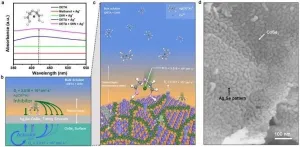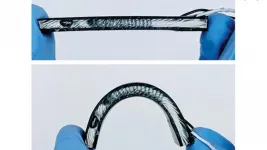Research foresees an end to deregulated competitive public transport
2021-03-08
(Press-News.org) Research from the University of Kent predicts an end to deregulated competitive pubic transport in the UK as a consequence of Covid-19 social distancing measures leading to drastically reduced ridership, requiring a major rethinking of the provision of public transport.
This paper, published in Transport Policy, argues that the situation will require a fundamental approach to long-term policy for transport as a whole. This is an opportunity to reconstruct the system whilst addressing such problems as the environmental impact of transport, congestion and questions of transport justice such as accessibility to transport for disadvantaged groups in society.
Covid-19 has been a major disruptor on all aspects of the transport system, local, national and international. This has been significant for both the UK's public sector and private sector operators and has thrown most business models into disarray, demonstrating the system's fragility to crisis. Whilst the UK Government provides funding for services to continue amid the pandemic, the length of the emergency and the slow recovery threaten this ability to maintain support until demand returns to pre-pandemic levels.
In the UK central government borrowing in fiscal year 2020/21 is expected to reach almost £400 billion as the economy shrinks by an expected 11.3 per cent and unemployment rises to 7.5 per cent. Continued government funding for the public transport system is not sustainable for current pandemic levels of use, in which ridership is down across the system.
In addition to this, the increasing inequality in accessibility to transport according to income, age, disability and other individual and social characteristics was a pre-pandemic issue of major disparity, whilst the environmental crisis continues with transport accounting for a significant share of global emissions. These older issues continue and require immediate addressing.
The paper argues that returning to the old normal is unlikely and that public transport must adjust to increased home working and a fear of crowded spaces. This potentially spells the end of the prevailing model of a deregulated competitive public transport in the UK.
Roger Vickerman, Emeritus Professor of European Economics at Kent and author of the paper said: 'Public transport's flaws required urgent addressing prior to the pandemic and now much remains to be done in designing an inclusive transport system. In the light of the pandemic, we are presented with this opportunity now and may use it to establish a system that is efficient, environmentally considerate, and to the benefit of its users that currently suffer its disadvantages.'
INFORMATION:
The paper 'Will Covid-19 put the public back in public transport? A UK perspective' is published in Transport Policy (Professor Roger Vickerman, Emeritus Professor of European Economics, School of Economics, University of Kent).
https://www.sciencedirect.com/science/article/pii/S0967070X21000111?dgcid=author
DOI: 10.1016/j.tranpol.2021.01.005
ENDS
For further information or interview requests, please contact Sam Wood at the University of Kent Press Office.
Tel: 07713087981
Email: s.wood-700@kent.ac.uk
News releases can also be found at http://www.kent.ac.uk/news
University of Kent on Twitter: http://twitter.com/UniKent
Notes to Editors
The University of Kent is a leading UK university producing world-class research, rated internationally excellent and leading the way in many fields of study. Our 20,000 students are based at campuses and centres in Canterbury, Medway, Brussels and Paris.
With 97% of our research judged to be of international quality in the most recent Research Assessment Framework (REF2014), our students study with some of the most influential thinkers in the world. Universities UK recently named research from the University as one of the UK's 100 Best Breakthroughs of the last century for its significant impact on people's everyday lives.
We are renowned for our inspirational teaching. Awarded a gold rating, the highest, in the UK Government's Teaching Excellence Framework (TEF), we were presented with the Outstanding Support for Students award at the 2018 Times Higher Education (THE) Awards for the second year running.
Our graduates are equipped for a successful future allowing them to compete effectively in the global job market. More than 95% of graduates find a job or study opportunity within six months.
The University is a truly international community with over 40% of our academics coming from outside the UK and our students representing over 150 nationalities.
We are a major economic force in south east England, supporting innovation and enterprise. We are worth £0.9 billion to the economy of the south east and support more than 9,400 jobs in the region.
In March 2018, the Government and Health Education England (HEE) announced that the joint bid by the University of Kent and Canterbury Christ Church University for funded places to establish a medical school has been successful. The first intake of undergraduates to the Kent and Medway Medical School will be in September 2020.
We are proud to be part of Canterbury, Medway and the county of Kent and, through collaboration with partners, work to ensure our global ambitions have a positive impact on the region's academic, cultural, social and economic landscape.
ELSE PRESS RELEASES FROM THIS DATE:
2021-03-08
A new substance could improve the treatment of persistent cancers. Researchers at Martin Luther University Halle-Wittenberg (MLU) and the University of Greifswald have developed a new inhibitor that makes drug-resistant tumour cells respond again to chemotherapy. The new substance blocks a protein in the cancer cells that normally transports the cancer drugs back out of the cells. The results were published in the scientific journal Molecules.
In addition to radiation therapy, cytotoxic agents, also known as chemotherapy, are frequently used to treat cancer. They prevent cells from dividing and thus cancer cells are unable to multiply unchecked. "Cytotoxic agents remain a very important form ...
2021-03-08
In 1952, Alan Turing, the father of computer science and artificial intelligence, proposed that certain repetitive natural patterns may be produced by the interaction of two specific substances through the "reaction-diffusion" process. In this system, activator promotes the reaction and inhibitor inhibits the reaction. When the two meet, the reaction diffuses. When the difference in diffusion coefficient between the two reaches a certain level, the high diffusion ratio between them will cause the system imbalance and induce the formation of periodic complex patterns.
"Turing structure" exists widely in nature, such as the body patterns of zebras, the phyllotaxis of sunflowers, the follicle spacing of ...
2021-03-08
The precise choice of treatment for breast cancer depends upon the status of the hormone receptors (for oestrogen and progesterone). Their conventional determination by means of immunohistochemistry (IHC) is associated with a certain error rate, which can be reduced by adding genomic data. Even conventional statistics can bring about a notable improvement but now it is possible to use decision theory to optimally combine diagnostic findings, particularly where they are contradictory. This is the finding of a recent study conducted by MedUni Vienna under the leadership of Wolfgang Schreiner from the Center for Medical Statistics, Informatics and Intelligent Systems (CeMSIIS). The methodology has applications way beyond breast cancer and can be deployed ...
2021-03-08
Recently, research group, led by Prof. FU Yao and associate research fellow LU Xi From Hefei National Laboratory for Physical Sciences at the Microscale and School of Chemistry and Materials Science of the University of Science and Technology of China (USTC), has made significant achievements in the field of synthesis of chiral amines. They developed a mild and general nickel-catalysed asymmetric reductive hydroalkylation and realized the modular synthesis of chiral aliphatic amines.
Results were published in Nature Communications on Feb. 26, 2021.
Chiral amines are important chiral auxiliaries and key synthetic intermediates of pharmaceuticals and natural products. ...
2021-03-08
With the help of the European Southern Observatory's Very Large Telescope (ESO's VLT), astronomers have discovered and studied in detail the most distant source of radio emission known to date. The source is a "radio-loud" quasar -- a bright object with powerful jets emitting at radio wavelengths -- that is so far away its light has taken 13 billion years to reach us. The discovery could provide important clues to help astronomers understand the early Universe.
Quasars are very bright objects that lie at the centre of some galaxies and are powered by supermassive black holes. As the black hole consumes the surrounding gas, energy is released, allowing astronomers to ...
2021-03-08
Astronomers using the National Science Foundation's Karl G. Jansky Very Large Array (VLA) and Very Long Baseline Array (VLBA) have found and studied the most distant cosmic jet discovered so far -- a jet of material propelled to nearly the speed of light by the supermassive black hole in a quasar some 13 billion light-years from Earth. The quasar is seen as it was when the universe was only 780 million years old, and is providing scientists with valuable information about how galaxies evolved and supermassive black holes grew when the universe was that young.
The studies indicate that the quasar -- a galaxy harboring a black hole 300 million times more massive than the Sun -- has a jet of fast-moving particles only about 1,000 years ...
2021-03-08
COLUMBUS, Ohio - Multinational companies headquartered in countries with tougher environmental policies tend to locate their polluting factories in countries with more lax regulations, a new study finds.
While countries may hope their regulations will reduce emissions of carbon dioxide and other greenhouse gases, these results show that these policies can lead to "carbon leakage" to other nations, said Itzhak Ben-David, co-author of the study and professor of finance at The Ohio State University's Fisher College of Business.
"Firms decide strategically where to locate their production based ...
2021-03-08
North Carolina State University engineers continue to improve the efficiency of a flexible device worn on the wrist that harvests heat energy from the human body to monitor health.
In a paper published in npj Flexible Electronics, the NC State researchers report significant enhancements in preventing heat leakage in the flexible body heat harvester they first reported in 2017 and updated in 2020. The harvesters use heat energy from the human body to power wearable technologies - think of smart watches that measure your heart rate, blood oxygen, glucose and other health parameters - that never need to have their batteries recharged. The technology relies on the same principles ...
2021-03-08
Rome, Italy, March 8, 2021 - Allelica, a leading genomics software company specialising in developing polygenic risk scores (PRS) for personalised medicine, today announced publication of a study in Circulation (Vol. 143, Issue 10) showing that the effect of LDL cholesterol on a person's risk of having a heart attack depends on their genes. Using Allelica's proprietary PRS analysis software, the data showed that combining information on an individual's genetic risk of heart attack with their LDL level helps determine those at most risk from heart attack, including those potentially in need of treatment with statins or PCSK9 inhibitors. The PRS was also able to identify individuals eligible for therapeutic intervention based on current ...
2021-03-08
To avoid a substantial increase in water scarcity, biomass plantations for energy production need sustainable water management, a new study shows. Bioenergy is frequently considered one of the options to reduce greenhouse gases for achieving the Paris climate goals, especially if combined with capturing the CO2 from biomass power plants and storing it underground. Yet growing large-scale bioenergy plantations worldwide does not just require land, but also considerable amounts of freshwater for irrigation - which can be at odds with respecting Earth's ...
LAST 30 PRESS RELEASES:
[Press-News.org] Research foresees an end to deregulated competitive public transport



